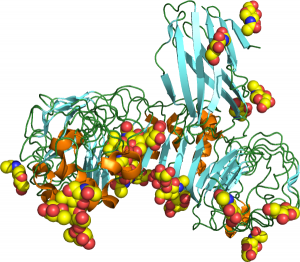A New Way to Treat Chemotherapy Pain

TLR4 Protein Structure
A new way to treat chronic pain without the use of opioids was found by researchers at the University of California San Diego School of Medicine. The treatment is a spinal injection containing apolipoprotein A-I binding protein (AIBP), which binds to toll-like receptor 4 (TLR4), a receptor on the surface of cells that detects infectious agents and possible tissue damage.
The study was published in Cell Reports on May 29th and reported that the mice used in the trial had no chemotherapy pain for two months following a single injection of the treatment.
Opioid use to treat pain
Opioids, such as morphine, are commonly used in the treatment of chronic pain. However, their use is not unflawed. Although opioids do dampen the feeling of pain, they do not cut off the source of the discomfort; they just mask the feeling. The false feeling of pleasure that opioids provide also induces the potential for misuse or even abuse.
According to the National Institute on Drug Abuse, prescription opioid misuse costs the United States $78.5 billion a year, and in 2015, prescription opioid pain relievers led to about two million people in the US suffering from substance abuse disorders. The same article states that 21-29% of opioid prescriptions result in misuse, leading to more than 115 opioid overdose deaths in the US every day.
Cancer patients are one group often prescribed opioids to alleviate pain. Of the 1.7 million people diagnosed with cancer every year, at least 39 percent experience pain from their cancer and chemotherapy treatment.
AIBP use for chemotherapy pain
Using the AIBP spinal injection to treat chemotherapy pain alleviates the potential for opioid abuse. Rather than masking the pain, the AIBP treatment eliminates pain from the source by inhibiting the inflammatory response underlying chronic pain processing. Specifically, the treatment inhibited the TLR4 receptor, removing cholesterol from lipid rafts in microglia immune cells while reducing TLR4 activation, microglial activation and spinal cord inflammation.
The study proved the treatment was effective in mice, relieving chemotherapy-induced pain for two months. There were no side effects, with mouse motor function remaining intact.
The AIBP injection provokes the idea of replacing the need for opioids in the treatment of chemotherapy pain all together. The treatment is currently administered as a spinal injection, but in a recent press release, senior author Dr. Yury Miller says, “We are working on ways to deliver AIBP systemically, but if it comes down to a choice between living with chronic pain or getting a spinal injection once every few months, we think most people would take the injection.”
Do you work in this area of research? Our catalog offers unique lab-made reagents for studying cancer and chronic pain, such as these related materials:
- Apolipoprotein B Antibodies from Vanderbilt University
- Opioid Receptor Antibodies from Icahn School of Medicine at Mount Sinai
- Cannabinoid Receptor Cell Lines from Indiana University
- TLR4 SNP Expressing Mouse Hepatic Stellate Cell Lines from Icahn School of Medicine at Mount Sinai
- Microglial Cell Line (IMG) from Harvard University
- Microglial Cell Line (SIM-A9) from University of North Dakota


